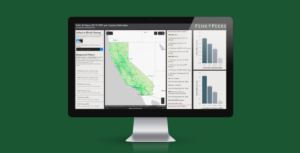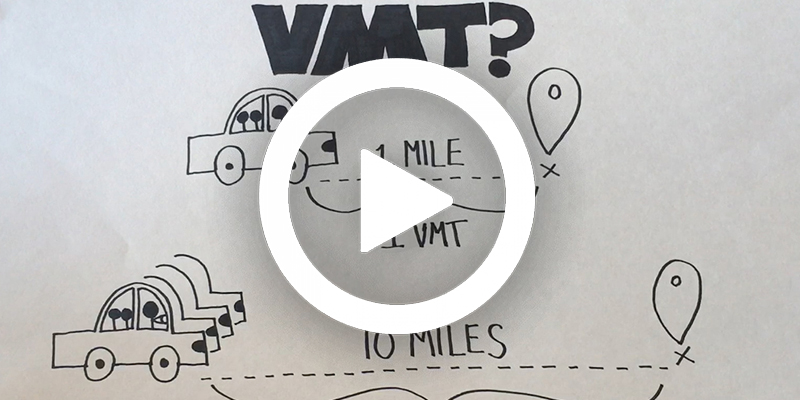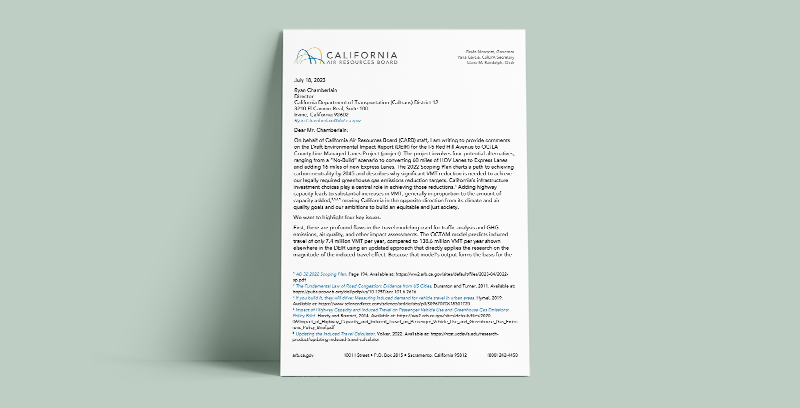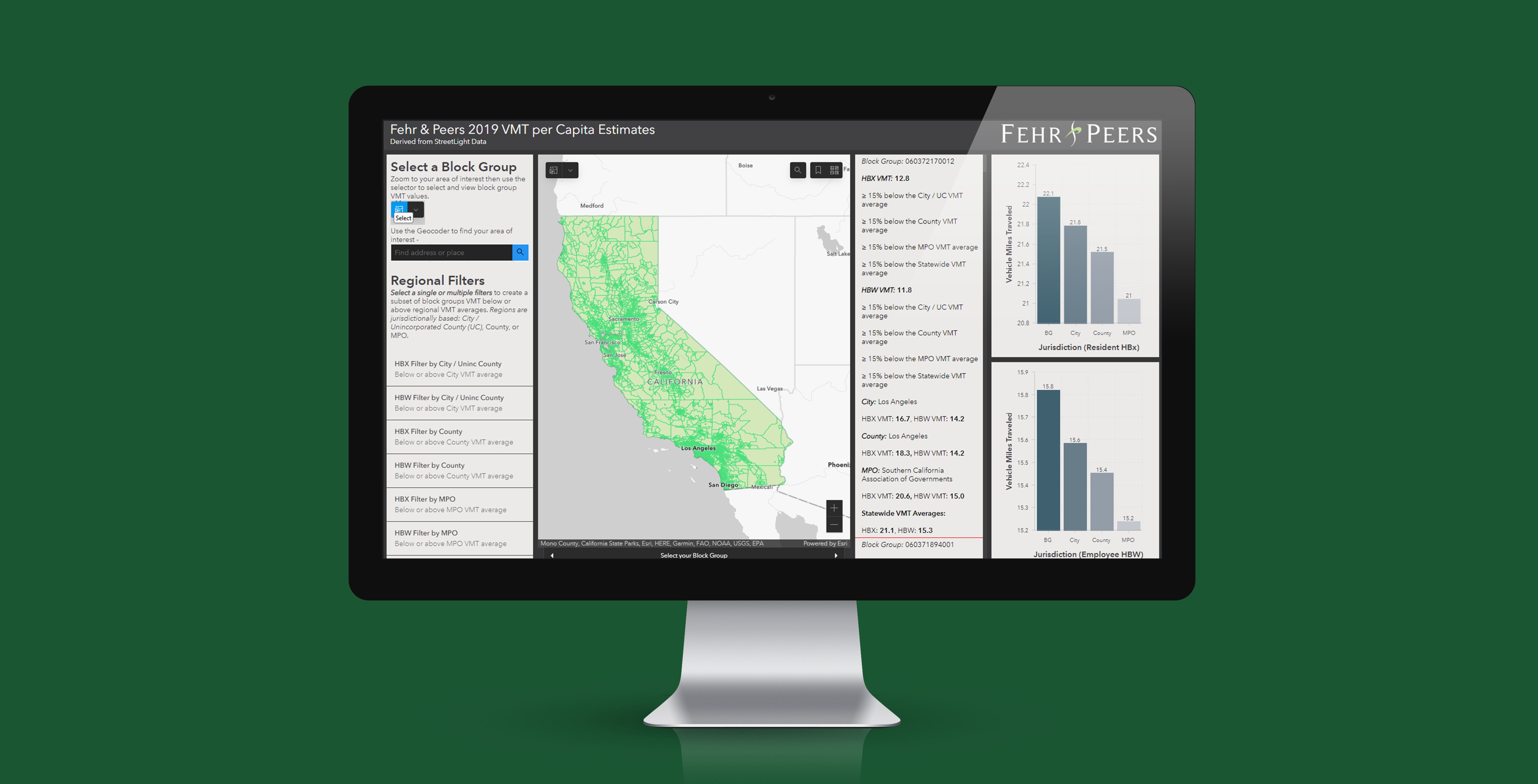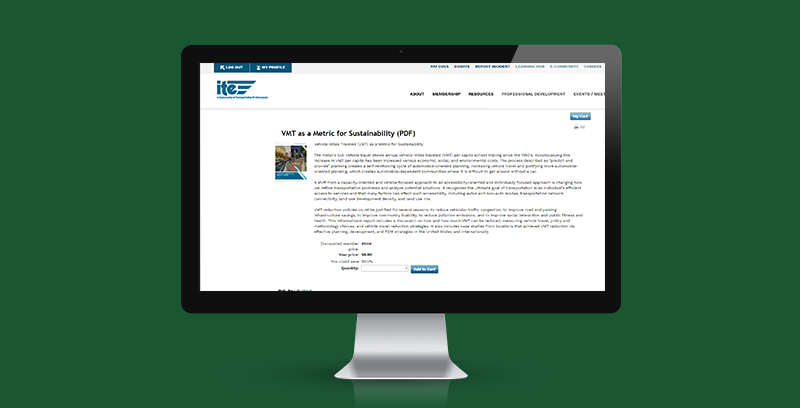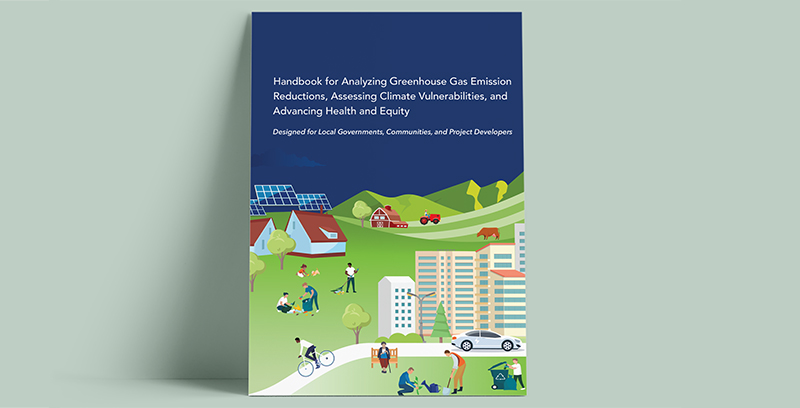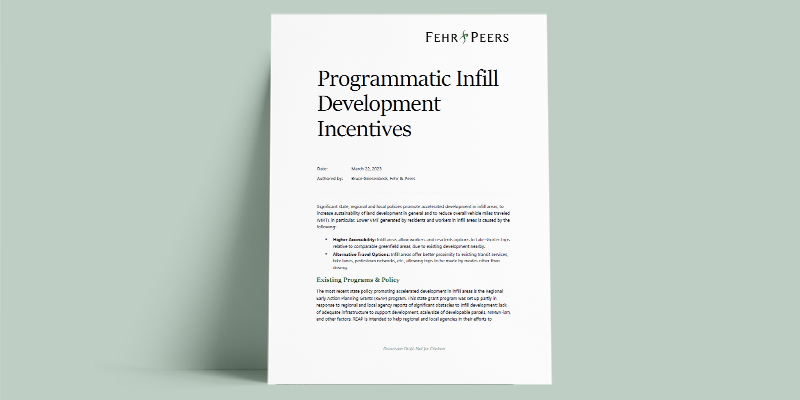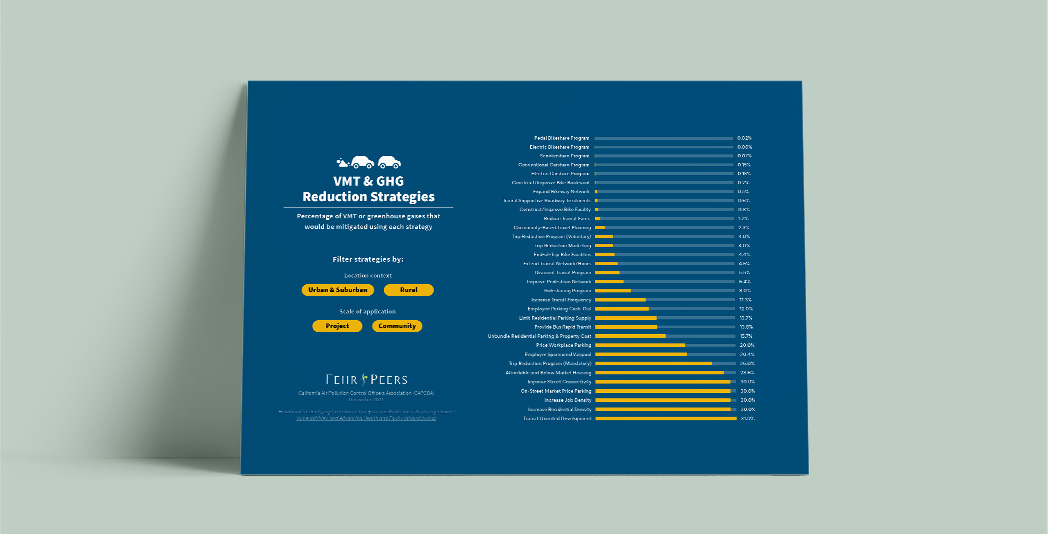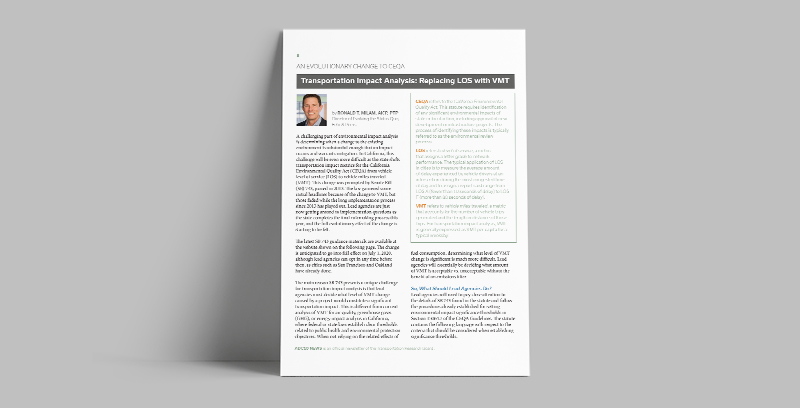California Senate Bill 743
Helping lead agencies in California understand the SB 743 shift from measuring the impact on drivers to measuring the impact of driving
California Senate Bill 743
Helping California lead agencies understand the SB 743 shift from measuring the impact on drivers to measuring the impact of driving.
Implementation Guidance
At Fehr & Peers, we recognize how different these new provisions are from conventional approaches, and we know the transition can be challenging. To outline critical steps and choices for agencies, we have developed guidance below. Let us help with breaking down the complexity and planning the path to conversion.
Induced VMT Analysis
Preview some of the new expectations for induced VMT analysis that are arising from California Air Resource Board reviews of recent highway projects.
Using VMT to Promote Sustainability
This resource offers practitioners insights and case studies using VMT as a metric to enhance equity, safety, environmental sustainability, and community livability.
Quantifying GHG (and VMT) Mitigation Measures
Exploring the updated CAPCOA Handbook, which is heavily relied on for developing VMT and emissions mitigation measures
“Priced Out”
Explore the white paper to learn how housing subsidy programs can reduce VMT (published as a draft for discussion).
CAPCOA VMT & GHG Reduction Strategies
Percentage of VMT or greenhouse gases that
would be mitigated using different strategies
Lead Agency Choices
Summarizing lead agency decisions, options, and recommendations related to VMT and SB 743 implementation

What Does SB 743 Not Do?
This question may be more important to some agencies than what SB 743 does. This statement is particularly true for cities or counties that feel that continued use of vehicle LOS is an important part of their transportation analysis process. In these communities, vehicle LOS analysis in CEQA documents has achieved the desired outcomes of the jurisdiction and they want to know if they will have to change their process due to SB 743. While a definitive answer won’t be possible until the final CEQA Guidelines are adopted, we do know that SB 743 did not change laws related to general plans, police powers granted to cities and counties by the State constitution, the subdivision map act, or traffic impact fee programs. As such, no changes have occurred for jurisdictions wanting to use vehicle LOS to size roadways in their general plan or determine nexus relationships for their impact fee programs. They can also continue to condition projects to build transportation improvements through the entitlement process in a variety of ways, such as using general plan consistency findings.
If anything, the potential loss of vehicle LOS (and similar measures) in CEQA could reinforce the importance of general plans and supporting implementation methods (such as impact fee programs) as the primary means for defining a jurisdiction’s policy approach to transportation. As the importance of general plans increases, it is worth noting that many general plan circulation elements were developed without consideration of capital and O&M financial constraints. These constraints often become apparent in subsequent project-level environmental reviews, frequently leading to significant and unavoidable impact findings because the jurisdiction does not have financial mechanisms that generate sufficient funding to build all of the circulation element improvements. Jurisdictions may also find themselves in this situation if the traffic impact fee necessary to fully fund the circulation element exceeds a reasonable level that could be supported within the development marketplace.
Ideally, the general plan would establish vehicle LOS expectations (and commensurate development levels) based on the amount of infrastructure the jurisdiction could afford to build, operate, and maintain. Development projects consistent with this type of general plan would require little (or no) vehicle LOS impact analysis, but instead could focus on issues such as multi-modal site access and parking provision to comply with applicable design standards. This could substantially reduce the effort required in typical CEQA transportation impact studies. In order to achieve this outcome, jurisdictions may need additional resources to update their general plans and transportation financing programs, which is an issue for further discussion.
Implementation Resources
Implementation resources, forecasting methodology recommendations, thresholds, mitigation strategies, and annotated flowcharts have been specifically designed for navigating and understanding SB 743 requirements.
VMT is the New Metric of Analysis
For those new to VMT analysis, this short video explains a few basic components of VMT. SB 743 adds VMT to the transportation impact analysis of CEQA documents.
VMT Lexicon
It’s important to be able to understand and navigate all types of VMT calculations. Our new quick-reference VMT lexicon makes that easier. Explore it now here.
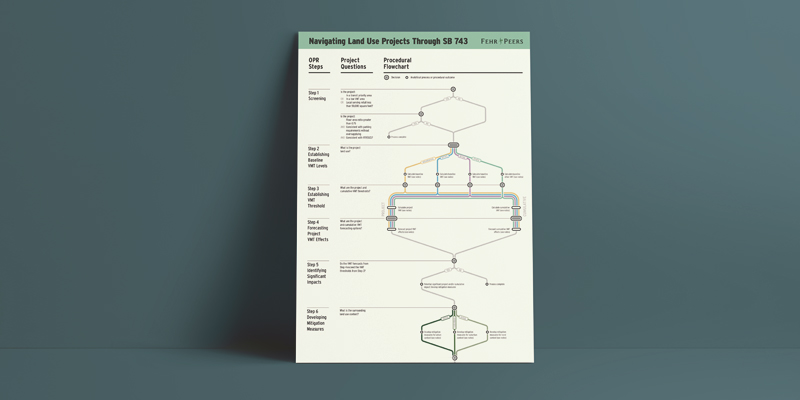
How does SB 743 apply to my project?
Curious about how to navigate your land use project, transportation project, or general plan through SB 743? We’ve developed these flowcharts to help:
Implementation Questions
All lead agencies will need to answer the following SB 743 implementation questions:
What is the preferred methodology for estimating and forecasting VMT, considering that this metric is a required input for air quality, energy, GHG, and now transportation impact analysis in CEQA?
If the lead agency wants to follow the OPR Technical Advisory recommendations, what travel forecasting model will be used to estimate baseline VMT for citywide or regional averages?
How will the lead agency ensure that project-scale VMT analysis is consistent with the methodology used to estimate thresholds?
What are the significance thresholds for VMT impacts under ‘baseline’ and ‘cumulative’ conditions?
Does the lead agency accept the OPR Technical Advisory recommendation that land use projects and plans within metropolitan planning organization (MPO) areas can achieve a 15% reduction in VMT per capita or per worker compared to existing conditions?
Does the lead agency want to take advantage of VMT impact screening?
Will VMT impact screening be allowed for residential and employment land uses based simply on location within a transit priority area (TPA) or low-VMT generating area?
Will screening also be allowed for local-serving retail projects consisting of less than 50,000 square feet?
What mitigation does the lead agency consider to be feasible for VMT impacts?
If TDM is used, how will the lead agency verify its effectiveness over time, since many TDM programs are building tenant dependent?
Additional Resources
While SB 743 implementation is still evolving, a variety of public, private, and institutional entities have contributed to creating implementation resources and addressing the key implementation questions.
Key Publications on VMT
Click to view key VMT publications and CEQA guideline updates.
Smart Transportation Metrics for Smart Growth
Click here to view a PDF on Smart Growth.
FHWA Publication on Forecasting VMT
Fehr & Peers contributed to the Handbook for Estimating Transportation Greenhouse Gases for Integration into the Planning Process published by FHWA in 2013. FHWA describes the publication as “..a handbook designed to provide information on how to analyze on-road greenhouse gas emissions at the state and regional level, and how to incorporate those analyses into transportation planning efforts.” The handbook is actually quite a bit more than that, because it also includes substantial detail on how to forecast VMT, given its importance in mobile GHG emissions. Key information includes step-by-step calculations and summary strengths and weaknesses for each VMT forecasting method.
Caltrans VMT Guide
Click to view Caltrans VMT Guide on embracing vehicle miles traveled as the traffic metric for environmental project analysis.
Leaving LOS Behind
Click to view a PDF on Leaving LOS Behind.
2010-2012 California Household Travel Survey
Click here to view a PDF of the results of a 2010-2012 California Household Travel Survey.
Additional Research on LOS
Transportation impact analyses in California have largely focused on auto LOS, which measures transportation network performance only from a driver’s perspective. This document, authored by Fehr & Peers Principal Ron Milam, explains the limitations of this traditional analysis approach and provides additional methods for a more complete analysis.
In addition to viewing the paper online, you may also Download iBook at iTunes or Contact the author, Ron Milam.
SB 743 Implementation Assistance Project
This project serves as an effort to help government agencies, businesses, and communities understand and implement this technical change. Click here for a set of case studies, workshops, presentations, resources, and an online educational course.
Contact Us
Interested in creating a customized VMT approach for your community?
Connect today with one of our experts:
Northern California
Ron Milam, Principal
San Francisco, Bay Area
Julie Morgan, Principal
Southern California
Jason Pack, Principal
San Diego Area
Katy Cole, Principal
Quick Links
© 2017 – 2024 Fehr & Peers. All rights reserved.

